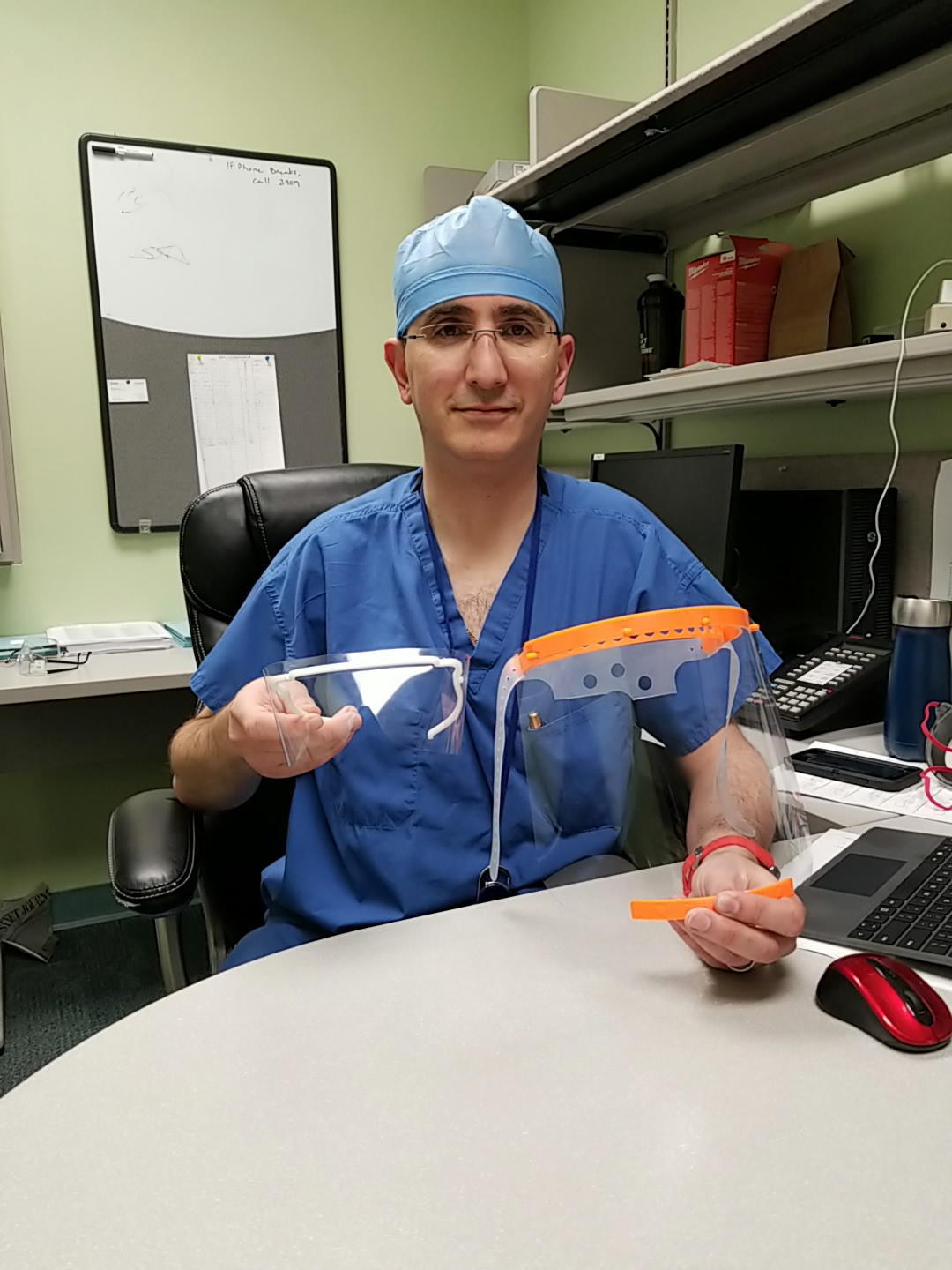As an acute care surgeon—a specialty encompassing trauma, critical care and emergency surgery—Hanna is well versed in acting quickly during times of crisis—evaluating critical problems and using his skills to help craft a solution. Perhaps it is no surprise, then, that he took this same approach and translated it to the current COVID-19 global pandemic.
Hanna serves as assistant professor and medical director of emergency general surgery in Rutgers Robert Wood Johnson Medical School’s Division of Acute Care Surgery, where he works with the trauma and acute care surgery teams at Robert Wood Johnson University Hospital. He is also a 3D printing enthusiast, now using his skills to help find solutions to dwindling PPE (personal protective equipment) resources.
A few days after reading about how Czech inventor and one of the giants in the 3D printing industry, Josef Prusa, had developed a series of Ministry of Health–verified prototypes to create a design for face shields, Hanna learned healthcare teams in the area were running low on this PPE and immediately thought he could help provide a solution.
“I used Prusa’s design for the face shield and went to Staples to pick up some Fellowes crystal presentation covers, which I cut out by hand to create the clear shield,” Hanna said. “I found a design for eye shields that is practically identical to the commercially purchased ones we use here and started 3D printing those as well. I really focused on those because there are technological limitations that make face mask production more difficult.”
Because safety is critical, Hanna said he limited his current efforts to designs that have already been industry-proven. Face masks and filters are still being tested with regard to their safety and efficacy, but more is expected to come in that area as large corporations such as Hewlett Packard submit their 3D-printed designs for expedited approval and review, he noted.
Hanna initially produced eight face shields and 10 eye shields, which he distributed to the acute care surgery division at Robert Wood Johnson University Hospital New Brunswick, as well as the Intensive Care Unit at Robert Wood Johnson University Hospital Somerset. He already has received requests for additional shields from other departments as well. And, since the shields can be sterilized with ultraviolet (UV) light, they are a valuable resource in the event PPE supplies become more limited.
Because the 3D printing machines he has at home are intended for hobby, rather than industrial use, the number of face/eye shields he is able to produce is limited.
“Anyone who needs it, I would love to help. It’s just a slow process and not a very high volume,” Hanna said. “But, if we can mobilize the 3D printing community to use the tested patterns that are out there, it would be a great way to help meet what’s needed. If even 1,000 of the hobbyists in New Jersey and the surrounding area could print 10 face shields, that’s an additional 10,000 shields we’d have for the healthcare providers who need them.”
Rutgers is now in the process of coordinating efforts of Hanna and others’ 3D printing expertise as part of an RU 3D PPE Project (or RU3DP2 for short) to bring together the university’s wealth of knowledge, skills and abilities to assist the Rutgers COVID-19 Task Force in overcoming shortages of PPE for frontline health care workers.
About Rutgers Robert Wood Johnson Medical School
As one of the nation’s leading comprehensive medical schools, Robert Wood Johnson Medical School is dedicated to the pursuit of excellence in education, research, health care delivery, and the promotion of community health. Part of Rutgers, The State University of New Jersey, Robert Wood Johnson Medical School encompasses 20 basic science and clinical departments, and hosts centers and institutes including The Cardiovascular Institute, the Child Health Institute of New Jersey, and the Women’s Health Institute. The medical school has been recognized by U.S. News & World Report as among the top 100 medical schools in the nation for research and primary care. Robert Wood Johnson Medical School and Robert Wood Johnson University Hospital, an RWJBarnabas Health facility and the medical school’s principal affiliate, comprise one of the nation’s premier academic medical centers. Clinical services are provided by more than 500 faculty physicians in 200+ specialties and subspecialties as part of Rutgers Health, the clinical arm of Rutgers University. Rutgers Health is the most comprehensive academic health care provider in New Jersey, offering a breadth of accessible clinical care throughout the state supported by the latest in medical research and education. Robert Wood Johnson Medical School maintains educational programs at the undergraduate, graduate and postgraduate levels on its campuses in New Brunswick and Piscataway and provides continuing education courses for health care professionals and community education programs. With more than 5,500 alumni since the start of its first class in 1966, the medical school has expanded its comprehensive programming and educational opportunities and is at the forefront of innovative curriculum development and a visionary admissions program. To learn more about Rutgers Robert Wood Johnson Medical School, visit rwjms.rutgers.edu.
Original post https://alertarticles.info



